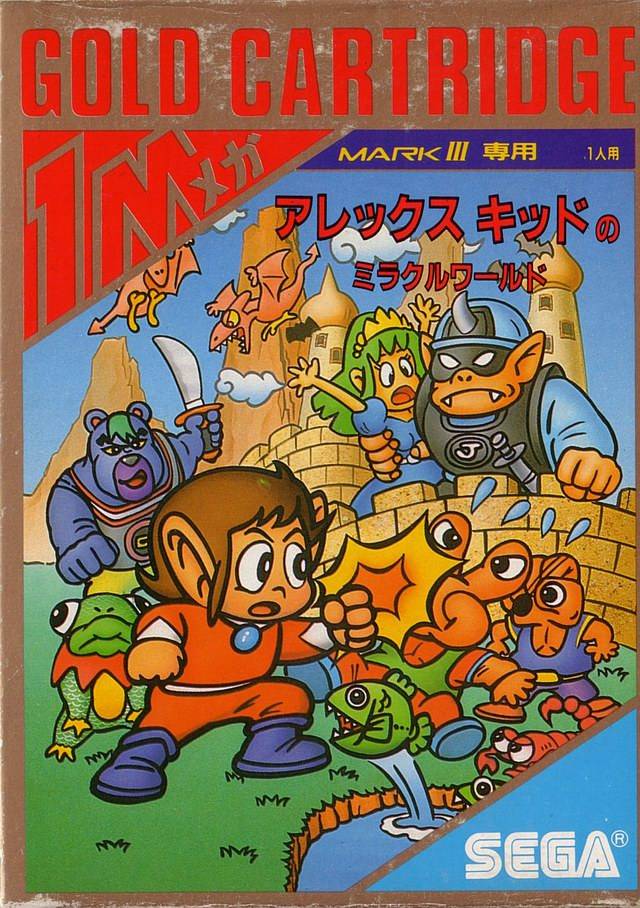
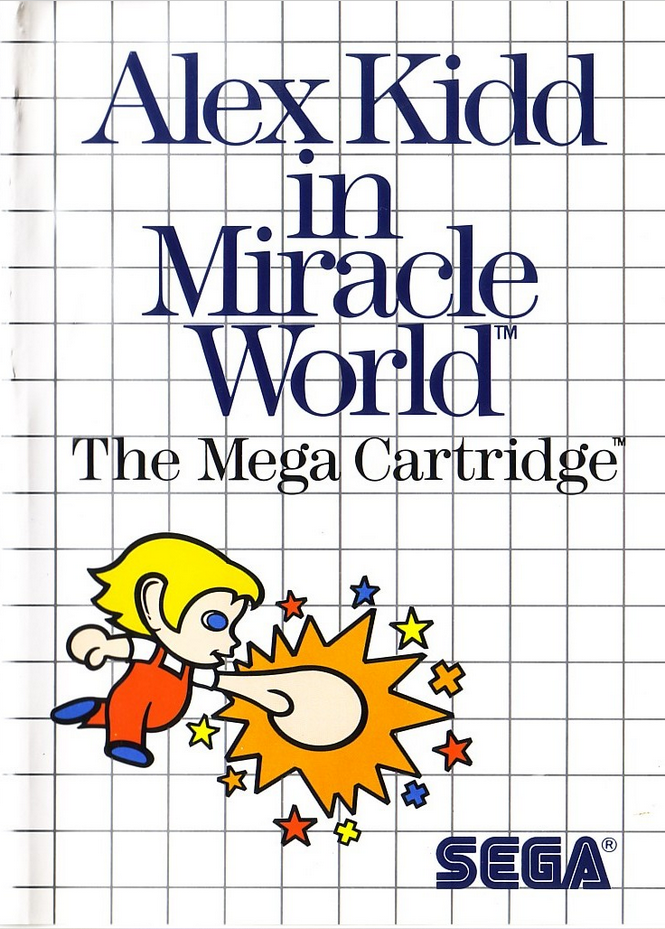
PLAYERS: 1
PUBLISHER/DEVELOPER: Sega
GENRE: Platformer
RELEASE DATE: 11/01/86 – (JP), 12/86 – (US), 09/87 – (EU)
Full disclaimer for those who may not know: I’m a life-long Nintendo fan. I grew up on the NES and the SNES and believe the early Mario games are some of the greatest games ever made. As a kid, I knew nothing about Sega’s Master System and even less about the console’s sort-of mascot, Alex Kidd. Part of that was Sega of America’s fault. Master System advertising in the States was nonexistent compared to Nintendo’s. Why else would I have wanted an NES, aged 4, unless I saw dozens of commercials showcasing blurry clips of Super Mario Bros. during my cartoons?
As I grew older and pored over vintage gaming magazines, Alex Kidd came into my periphery. I learned that he was Sega’s go-to character prior to Sonic, and that he starred in a handful of games, many of them with different play styles. I also learned that, once Sonic entered the picture and proved to be a huge success, Alex Kidd was all but forgotten by the company. Not, however, by those who grew up with Alex, and to this day swear his adventures are *gasp!* better than Mario’s. I wouldn’t go that far, but I would encourage Nintendo fans to give Alex Kidd a non-biased playthrough, if only to experience a refreshing, inventive platformer that plays like what Mario would become, rather than what he was in 1986.
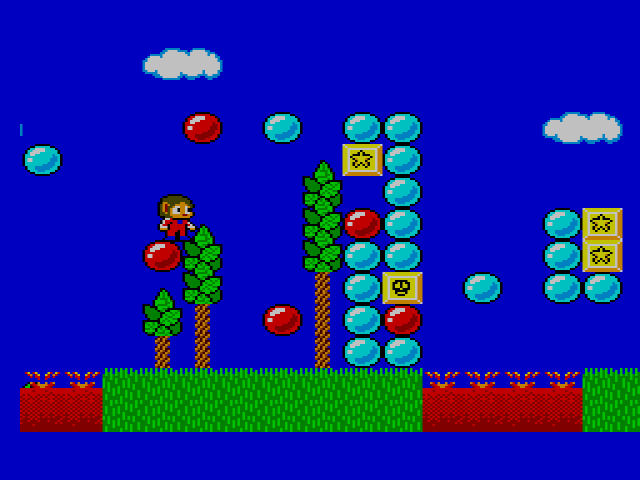
Alex Kidd in Miracle World is the inaugural game in the series and was obviously created to counter Nintendo’s own wildly successful Super Mario Bros. The two games play nothing alike, though. Super Mario Bros is a run-and-jump arcade platformer, designed for Mario to propel through the levels as quickly as possible (while still rewarding those who search for secrets). Alex Kidd slows down the action, encouraging cautious movements and thorough observation. The game’s adventure elements and occasional non-linear exploration were downright forward-thinking, compared to Mario‘s intense, but straightforward progression. Indeed, Alex Kidd may have emerged as Sega’s response to Mario’s Mushroom Kingdom high jinks, but there was no question that the former was more ambitious in its goals than the latter.
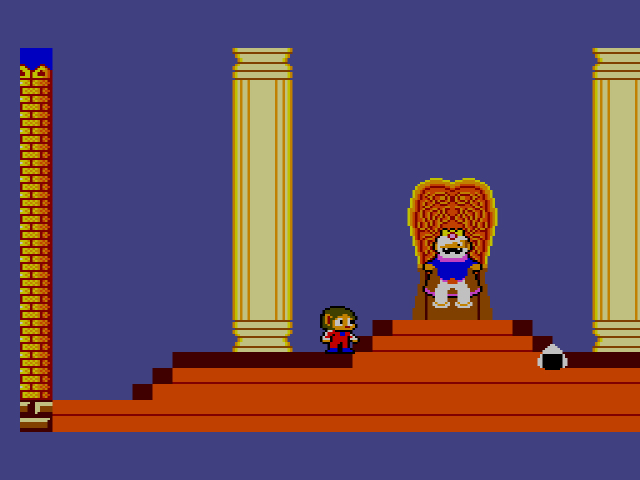
You play as Alex, a monkey-like child with large ears, fluffy sideburns, and an affinity for rice balls. Alex is brought away from his studies in “Shellcore” to rescue his brother, Egul, and the Princess Lora from the evil king, Janken and his disturbing-looking cronies, Rock Head, Paper Head, and Scissor Head. The story is one of the least memorable aspects of the game, and at times, it seems like Sega’s trying too hard to build a mythology around Alex and the world he inhabits (preparing him for future games, perhaps?). Then again, Mario’s “rescue the princess” plot line was pretty one-note, and Nintendo continues to recycle it for the majority of their mainline Mario games, so who am I to judge?
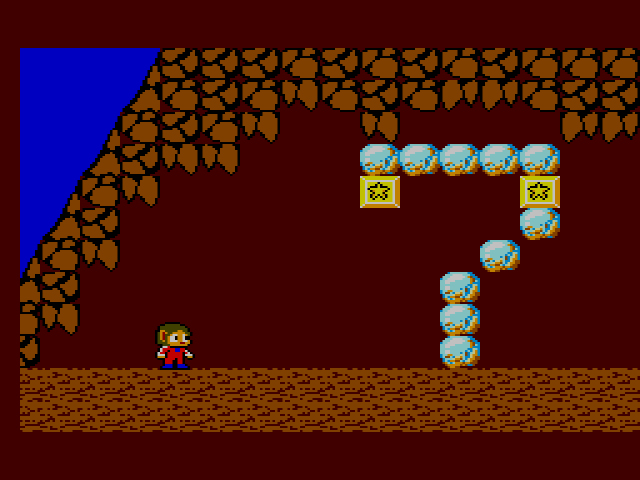
As Alex journeys through Planet Aeries (the “Miracle World” from the title?), he’s equipped with only his fist, enlargened by years of Shellcore smackdowns. His fist is powerful, but has a short reach, which makes defeating enemies a burden at times; Alex is a one-hit-and-he’s-dead type of fella, so if you’re going to punch an enemy moving toward you, be certain that you’ll connect. Your best bet is to find and equip the bracelet, a power-up that enables Alex to punch projectiles – shock waves of fist – through the air, obliterating everything it touches.
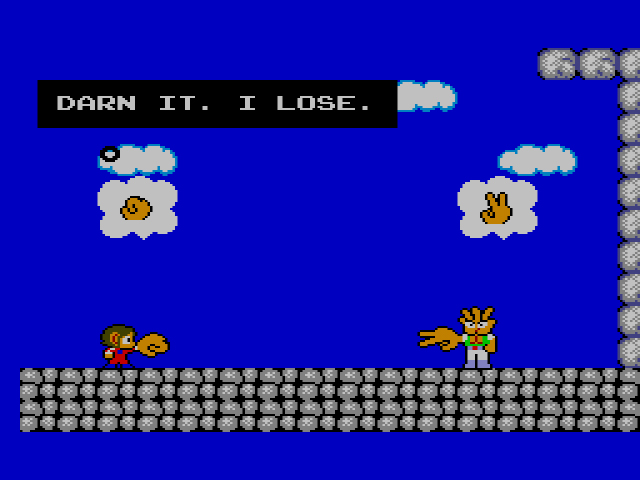
Alex uses his fist for everything: from RPS matches, to punching through blocks and power-ups, to getting chicks (presumably). Blocks, in particular, are everywhere in Alex Kidd and provide every range of service, from platforms to power-ups to hiding little Grim Reapers that chase and kill you. The best blocks, though, are the ones with money sacks in them. As in real life, money in Alex Kidd makes your earthly toil a whole lot easier. Collect as many sacks as you can, so that when you reach a shop, you can buy power-ups, vehicles, and extra lives.
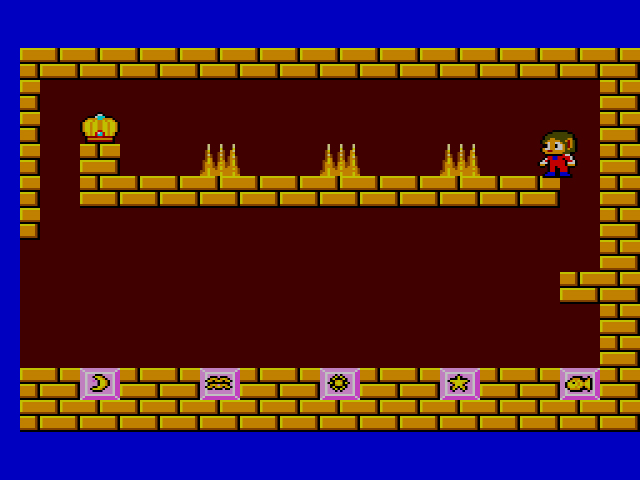
Shops appear at the beginning of a level, every three or four levels. Whatever a particular shop is selling is usually a good indicator of what you’ll need in the level ahead. Vehicles and extra lives are immediately accessible once you buy them, but when you buy a power-up, it goes into your item selection screen rather than being equipped automatically. The power-ups range from throwaways like the Cane of Flight that helps you fly across the screen for a limited time, to the essential Teleport Powder which grants you invisibility for about ten seconds.
The idea of amassing multiple power-ups to have at your disposal whenever you wish is an ingenious one that Nintendo would later borrow for Super Mario Bros. 3. The vehicles, too, are novel, even if they don’t work as well as they should. The Sukopako Motorcycle is fast and helps you break through rocks and enemies, but touch the wrong block or brick and it disintegrates. The best vehicle is the Peticoper, a foot-propelled helicopter that shoots missiles, but it too will go down with one hit if you hit the wrong blocks.
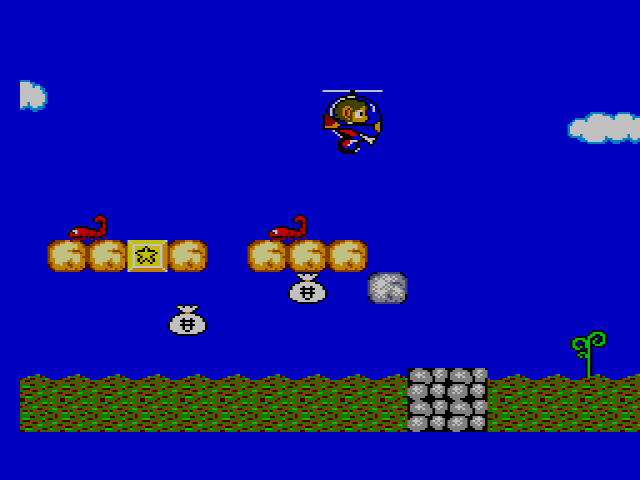
Unlike Mario’s stilted level-by-level progression through the Mushroom Kingdom, Alex’s journey through the Planet Aeries feels smooth, thanks to a world map that highlights your progress. Planet Aeries’ landscape is more colorful and varied than the Mushroom Kingdom, with no two levels resembling each other. Mt. Eternal has Alex progressing downwards through a mountain and into a body of water, then swimming his way out. The Blakwoods is a dense forest where monkeys throw seeds at you. Radaxian Castle is a puzzle-filled, non-linear maze, while the Kingdom of Nibana forces you to ride your Peticopter through dangerous red-orbed filled skies.
Boss fights are a mixture between straightforward attacks and rock, paper, scissors battles. The latter, in particular, are ridiculous best 2-of-3 matches with Janken’s minions whose heads are literally shaped by their love of rock, paper, scissors. Again, for 1986, the sheer variety of levels on display is astounding, especially when compared to Super Mario Bros’ repeating levels.
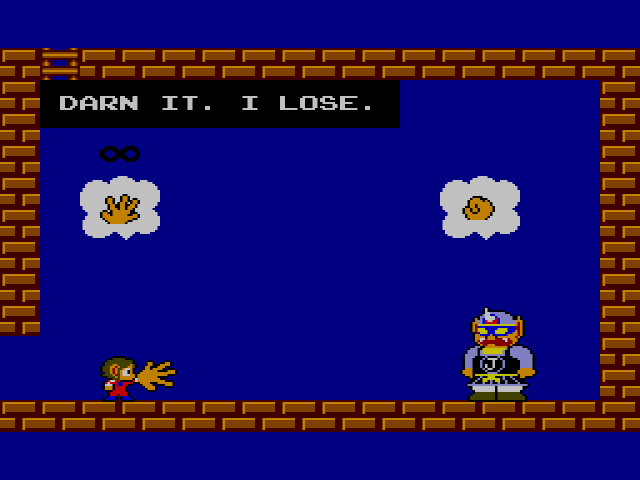
As usual, a game’s success boils down to how well it plays, and Alex Kidd plays pretty well. The game isn’t as fast-paced as the original Super Mario Bros., which I prefer, but it’s not trying to be. As the lack of a time limit indicates, Sega encourages the player to immerse themselves in Planet Aeries without feeling rushed. At first, I was annoyed with how slippery Alex Kidd controlled, but once I started taking my time through the levels, success came more readily. Not easily, though. Nothing about Alex Kidd in Miracle World is easy: from the one-hit kills to the lack of continues to the precise platforming sections that take advantage of Alex’s inherent slipperiness. You’ll have a helluva time getting through the game in one sitting, but such was the case with most games back in the day.
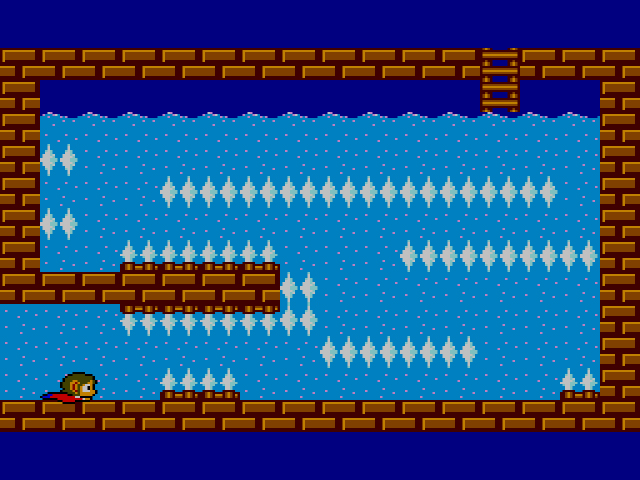
Alex Kidd in Miracle World was supposed to be “the one” for Sega: the breakout hit that would propel the company and its fledgling Mark III/Master System to Nintendo-like popularity. Despite what seemed like perfect timing, Alex Kidd never rose above “cult classic” level. Super Mario Bros. and the NES had Japan and America swooning, and Sega didn’t have the wherewithal to penetrate Nintendo’s dominance with the Master System. And while I would argue that Alex Kidd in Miracle World deserved better – both in 1986 and today – Super Mario Bros. is so ingrained within my being that I can’t help but view Alex as a lesser substitute. Alex Kidd took risks with the platforming genre when it debuted in 1986, but what did that matter to those of us who had fallen in love with the euphoric heights of Super Mario Bros? For millions of gamers, including myself, Mario defined platforming. Everything else was second best.
B+

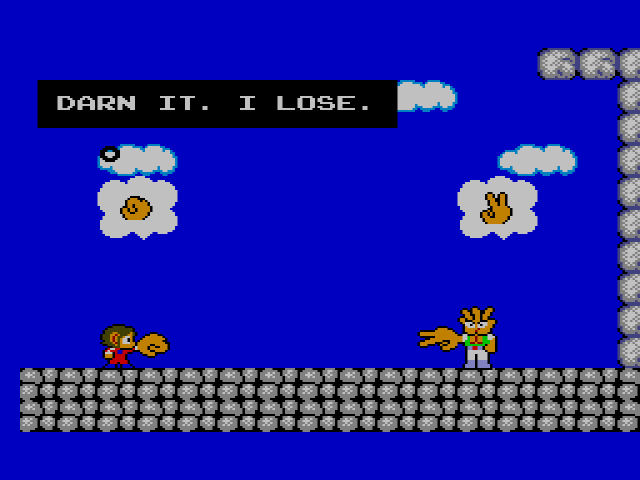
7 replies on “Alex Kidd in Miracle World (Master System, 1986)”
Great review. I think you really have to go into this game not trying to compare it to SMB because it really isn’t. It was really ambitious for what it tried to do but some things worked, and some didn’t. I remember not even bothering to buy the motorcycle after a while because you were somewhat better off without it, I always remember the bright colors and the catchy music. Not my favorite game, but once I figured out what you where supposed to do I enjoyed it. Did you find the secret room by punching the Octopus? The last puzzle before the crown would really frustrate me before I figured it out,
I agree about not trying to compare it to SMB. It’s hard at first, given what Sega was going for. But you hit the nail on the head when you say that once you figure out what to do, it’s much more enjoyable.
I didn’t find the secret room, but I read about it later. And yeah, the last puzzle was a bit ridiculous.
I’m indifferent on this one, I recognise the effort and good gameplay ideas but it just doesn’t do it for me. Shinobi World is my personal favourite Alex Kidd game.
I saw this
https://www.youtube.com/watch?v=i5sAqobQX2I
only just yesterday and immediately thought of Alex Kidd from the character’s color scheme. This is apparently influenced by Donkey Kong, and based on the chronology puts it between that and Alex Kidd. Researching this as I post, it seems Sanritsu and Sega did indeed have a partnership…
As for Miracle World, I’ve watched it longplayed, and while it looks competently developed, the vibe I get is that they sent it out the door before giving the designers a chance to add that little something extra. Then again, in that era the division of labor was next-to-nonexistent, so the programmers probably WERE the designers, and quite tired of looking at it. 😀
Woah, the main character looks just like Alex Kidd! That’s a crazy find. Was Dr. Micro Japan only?
Good question. This is all I was really able to find on it (and they don’t seem to draw a connection): http://www.hardcoregaming101.net/drmicro/drmicro.htm
I didn’t even realize the doctor was probably the villain, though I guess that’s in keeping with Donkey Kong.
Another vote here for Shinobi World. I love that game. Miracle World was the first SMS game I played and I enjoyed it, but some of the difficulty spikes felt pretty egregious.